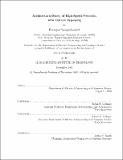| dc.contributor.advisor | Eytan H. Modiano. | en_US |
| dc.contributor.author | Saengudomlert, Poompat, 1973- | en_US |
| dc.contributor.other | Massachusetts Institute of Technology. Dept. of Electrical Engineering and Computer Science. | en_US |
| dc.date.accessioned | 2005-05-19T15:12:13Z | |
| dc.date.available | 2005-05-19T15:12:13Z | |
| dc.date.copyright | 2002 | en_US |
| dc.date.issued | 2002 | en_US |
| dc.identifier.uri | http://hdl.handle.net/1721.1/16897 | |
| dc.description | Thesis (Ph. D.)--Massachusetts Institute of Technology, Dept. of Electrical Engineering and Computer Science, 2002. | en_US |
| dc.description | Includes bibliographical references (p. 155-158). | en_US |
| dc.description | This electronic version was submitted by the student author. The certified thesis is available in the Institute Archives and Special Collections. | en_US |
| dc.description.abstract | We study the routing and wavelength assignment (RWA) problem in wavelength division multiplexing (WDM) networks with no wavelength conversion. In a high-speed core network, the traffic can be separated into two components. The first is the aggregated traffic from a large number of small-rate users. Each individual session is not necessarily static but the combined traffic streams between each pair of access nodes are approximately static. We support this traffic by static provisioning of routes and wavelengths. In particular, we develop several off-line RWA algorithms which use the minimum number of wavelengths to provide I dedicated wavelength paths between each pair of access nodes for basic all-to-all connectivity. The topologies we consider are arbitrary tree, bidirectional ring, two-dimensional torus, and binary hypercube topologies. We observe that wavelength converters do not decrease the wavelength requirement to support this uniform all-to-all traffic. The second traffic component contains traffic sessions from a small number of large-rate users and cannot be well approximated as static due to insufficient aggregation. To support this traffic component, we perform dynamic provisioning of routes and wavelengths. Adopting a nonblocking formulation, we assume that the basic traffic unit is a wavelength, and the traffic matrix changes from time to time but always belongs to a given traffic set. | en_US |
| dc.description.abstract | (cont.) More specifically, let N be the number of access nodes, and k denote an integer vector [k, k2, ..., kN]. We define the set of k-allowable traffic matrices to be such that, in each traffic matrix, node i, </= 1 </= N, can transmit at most ki wavelengths and receive at most ki wavelengths. We develop several on-line RWA algorithms which can support all the k-allowable traffic matrices in a rearrangeably nonblocking fashion while using close to the minimum number of wavelengths and incurring few rearrangements of existing lightpaths, if any, for each new session request. The topologies we consider are the same as for static provisioning. We observe that the number of lightpath rearrangements per new session request is proportional to the maximum number of lightpaths supported on a single wavelength. In addition, we observe that the number of lightpath rearrangements depends on the topological properties, e.g. network size, but not on the traffic volume represented by k as we increase k by some integer factor. Finally, we begin exploring an RWA problem in which traffic is switched in bands of wavelengths rather than individual wavelengths. We present some preliminary results based on the star topology. | en_US |
| dc.description.statementofresponsibility | by Poompat Saengudomlert. | en_US |
| dc.format.extent | 158 p. | en_US |
| dc.format.extent | 1091738 bytes | |
| dc.format.extent | 1091490 bytes | |
| dc.format.mimetype | application/pdf | |
| dc.format.mimetype | application/pdf | |
| dc.language.iso | eng | en_US |
| dc.publisher | Massachusetts Institute of Technology | en_US |
| dc.rights | M.I.T. theses are protected by copyright. They may be viewed from this source for any purpose, but reproduction or distribution in any format is prohibited without written permission. See provided URL for inquiries about permission. | en_US |
| dc.rights.uri | http://dspace.mit.edu/handle/1721.1/7582 | |
| dc.subject | Electrical Engineering and Computer Science. | en_US |
| dc.title | Architectural study of high-speed networks with optical bypassing | en_US |
| dc.type | Thesis | en_US |
| dc.description.degree | Ph.D. | en_US |
| dc.contributor.department | Massachusetts Institute of Technology. Department of Electrical Engineering and Computer Science | |
| dc.identifier.oclc | 52059340 | en_US |
